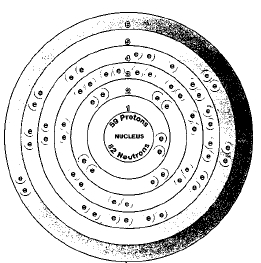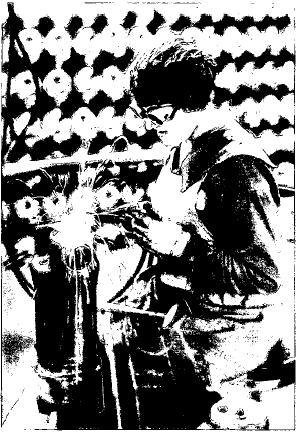PRASEODYMIUM

Overview
During the late 1830s and early 1840s, Swedish chemist Carl Gustav Mosander (1797-1858) was studying two puzzling minerals, ceria and yttria. Both minerals had been discovered more than fifty years earlier in remote parts of Sweden. The minerals were puzzling because they seemed to consist of a mixture of new elements. Mosander eventually showed that one of the elements in ceria produced pink compounds. He called the new element didymium.
A few years after didymium was discovered, Austrian chemist Carl Auer (Baron von Welsbach) (1858-1929) made a correction to Mosander's research. Didymium was not a pure element, Auer announced, but a combination of two other new elements. He called these elements meodymium and praseodymium.
SYMBOL
Pr
ATOMIC NUMBER
59
ATOMIC MASS
140.9077
FAMILY
Lanthanide
(rare earth metal)
PRONUNCIATION
PRAY-zee-oh-DIM-ee-um
Praseodymium lies in Row 6 of the periodic table. The periodic table is a chart that shows how chemical elements are related to each other. The elements that make up Row 6 are sometimes called the rare earth metals. But the term is not very accurate. The rare earth elements are not especially rare in the Earth's crust. They were given this name because they have very similar properties. This similarity makes them difficult to separate from each other. A better name for the rare earth elements is the lanthanides. This name comes from the first element in Row 6, lanthanum.
Praseodymium is a typical metal, somewhat similar to aluminum, iron, or magnesium. It is quite expensive to prepare and does not have many practical uses.
Discovery and naming
Mosander had been educated as a physician and a pharmacist. In the early 1830s, he was put in charge of the minerals collection at the Stockholm Academy of Sciences. He became very interested in two minerals that had been discovered in Sweden many years before, yttria and cerite. He devoted many years to studying the composition of these two minerals.
In 1841, Mosander announced that he had obtained two new elements from cerite. He called these elements lanthanum and didymium. He was correct about lanthanum being a new element, but he was wrong about didymium. This new "element" turned out to be a mixture of two other new elements, now called neodymium and praseodymium.
The man who made this discovery was Auer. He selected these two names because they mean "new twin" (neodymium) and "green twin" (praseodymium). The elements were called "twins" because they were both so much like lanthanum.
The praseodymium prepared by Auer was not very pure. It was contaminated with other elements. The first really pure sample of praseodymium was not made until 1931.
Physical properties
Praseodymium is a soft, malleable, ductile metal with a yellowish, metallic shine. Malleable means capable of being hammered into a thin sheet. Ductile means capable of being made into thin wires. Praseodymium has a melting point of 930°C (1,710°F) and a boiling point of about 3,200°C (about 5,800°F). Its density is 6.78 to 6.81 grams per cubic centimeter. Two allotropes of praseodymium exist. Allotropes are forms of an element with different physical and chemical properties. One allotrope, the "alpha" form, changes into a second allotrope, the "beta" form, at about 800°C.
Chemical properties
When it becomes moist, praseodymium reacts with oxygen in air to form praseodymium oxide. Praseodymium oxide (Pr 2 O 3 ) forms as a greenish-yellow scale (like rust) on the surface of the metal. To protect praseodymium for this reaction, it is stored under mineral oil or covered with a plastic wrap.
Like many other metals, praseodymium also reacts with water and with acids. In these reactions, hydrogen gas is released.
Occurrence in nature
Praseodymium is one of the more common lanthanides. It is thought to occur with an abundance of about 3.5 to 5.5 parts per million in the Earth's crust. It occurs primarily with the other rare earth elements in two minerals, monazite and bastnasite.
Isotopes
Only one naturally occurring isotope of praseodymium is known. Isotopes are two or more forms of an element. Isotopes differ from each other according to their mass number. The number written to the right of the element's name is the mass number. The mass number represents the number of protons plus neutrons in the nucleus of an atom of the element. The number of protons determines the element, but the number of neutrons in the atom of any one element can vary. Each variation is an isotope.
At least 15 radioactive isotopes of praseodymium are known also. A radioactive isotope is one that breaks apart and gives off some form of radiation. Radioactive isotopes are produced when very small particles are fired at atoms. These particles stick in the atoms and make them radioactive. None of the radioactive isotopes has any commercial use.
The original "discovery" of a "new" element called didymium turned out to be a mixture of neodymium and praseodymium.
Extraction
The first step in obtaining praseodymium is to treat monazite, bastnasite,
or another ore to separate the lanthanides from each other. The various
elements are then changed to compounds of
fluorine,
such as praseodymium fluoride (PrF
3
). Praseodymium metal can then be obtained by passing an electric current
through praseodymium fluoride:

It is still quite expensive to make praseodymium, and the metal sells for about $1,200 a kilogram ($2,500 a pound).
Uses
One of the oldest uses for praseodymium is in the manufacture of misch metal. Misch metal is pyrophoric, meaning that the metal gives off sparks when it is scratched. The most common use of misch metal is in lighter flints and tracer bullets. When a metal wheel is rubbed across misch metal in a cigarette lighter, the metal gives off sparks. Those sparks then set fire to lighter fluid, giving a flame to light a cigarette.
Like other lanthanides, praseodymium is also used to give color to glass, ceramics, enamels, and other materials. The characteristic color provided by compounds of praseodymium is a bright yellow.
A related use of praseodymium is in carbon arc lamps, like those used in the motion picture industry. When an electric current is passed through a carbon arc, the arc gives off a brilliant white light. The addition of a small amount of praseodymium gives a brilliant yellow cast to the light.
Praseodymium is also a component of didymium glass. Didymium glass contains a mixture of rare earth elements, including lanthanum, praseodymium, neodymium, samarium, cerium, and gadolinium. This glass is used to make welder's goggles. It helps protect the welder's eyes from the intense light produced during welding.
Compounds
Relatively few compounds of praseodymium have any commercial uses.
Praseodymium is used to give a bright yellow color to glass, ceramics, and enamels.
Health effects
The health effects of praseodymium are not well studied. As a safety measure, chemists treat the metal as if it were toxic and handle it with caution.
Comment about this article, ask questions, or add new information about this topic: